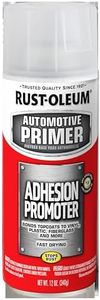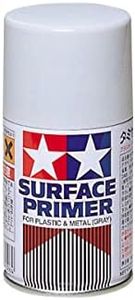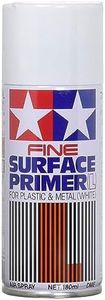We Use CookiesWe use cookies to enhance the security, performance,
functionality and for analytical and promotional activities. By continuing to browse this site you
are agreeing to our privacy policy
10 Best Automotive Primers
From leading brands and best sellers available on the web.By clicking on a link to a third party's website, log data is shared with that third party.
Buying Guide for the Best Automotive Primers
Choosing the right automotive primer is an important step for anyone working on car bodywork, whether you're repairing a small scratch or preparing an entire vehicle for repainting. Primers play a crucial role in providing a smooth base for paint, helping the paint adhere to metal, and protecting surfaces from rust and corrosion. Understanding which type of primer and key features are suited to your project will ensure the best results and long-lasting protection.Primer TypeThis refers to the kind of primer formulation, such as epoxy, urethane, self-etching, or filler primer. The type you choose matters because each offers different benefits—epoxy primers provide superior corrosion resistance and bonding, self-etching primers contain acids that help them stick to bare metal, while urethane primers are great for filling minor imperfections and are easy to sand. If your surface is mostly bare metal, self-etching or epoxy is often ideal; if you need to smooth out rough areas, a high-build or filler primer may be better. Consider your project's needs: for classic car restoration (lots of bare or rusty metal), corrosion resistance should be a priority, while for mild bodywork, easy sanding and filling may be more important.
Drying TimeDrying time is how long the primer takes to cure enough for sanding or painting. Fast-drying primers can help you speed up the project, but they may provide less time to fix imperfections before the primer sets. Slower-drying versions generally level out better for a smoother end result. If you're working in a professional shop and need speed, a fast-drying primer might suit you, while DIYers may prefer longer drying times for an easier application process.
Build ThicknessBuild thickness, often called 'high-build,' refers to how much the primer can fill in minor scratches or surface imperfections. High-build primers are thicker and are applied in layers to create a smooth finish, which is excellent when working with uneven or repaired surfaces. Standard-build primers are thinner and better for surfaces already smooth. Assess your surface: if you've done body filler or have minor damage to smooth out, high-build is likely your best bet; if your panels are already well-prepped and even, a standard-build primer will be sufficient.
Surface CompatibilitySurface compatibility specifies what materials the primer will adhere to properly—like bare metal, plastic, fiberglass, or previously painted surfaces. Not all primers stick well to all surfaces, so choosing one that matches the materials you're treating is crucial for adhesion and durability. If you're priming multiple types of surfaces, look for a primer labeled as 'multi-surface' or ensure separate appropriate primers for each material. Knowing your project materials will guide you here.
Sanding PropertiesSanding properties tell you how easily the primer can be sanded smooth after application, which is important to achieve an even paint job. Some primers sand effortlessly to a fine finish, while others are tougher or may clog sandpaper. If you want a glass-smooth finish or you're doing a lot of sanding between coats, prioritize easy-to-sand formulations. For situations where sanding isn't needed or you’re painting hard-to-reach areas, this spec is less crucial.
















